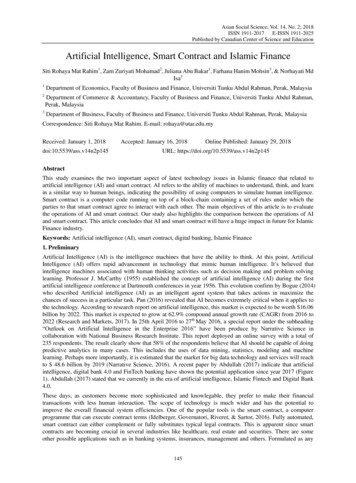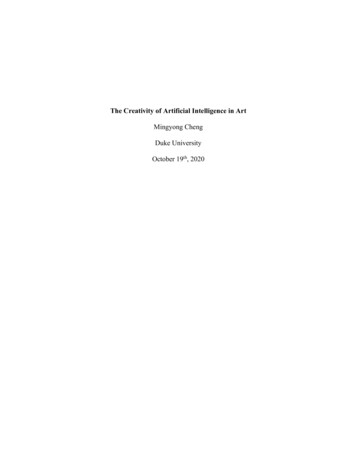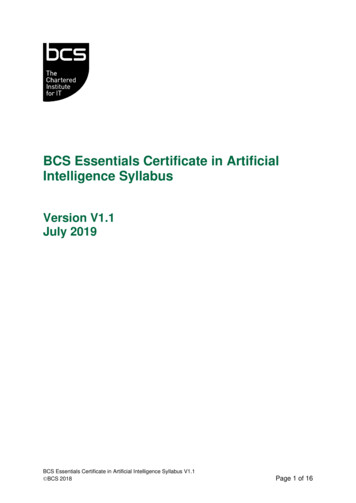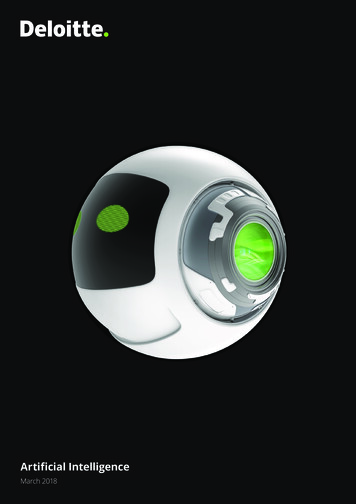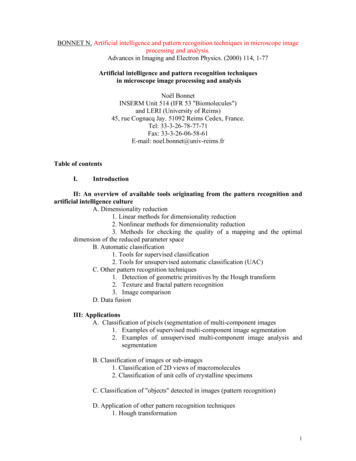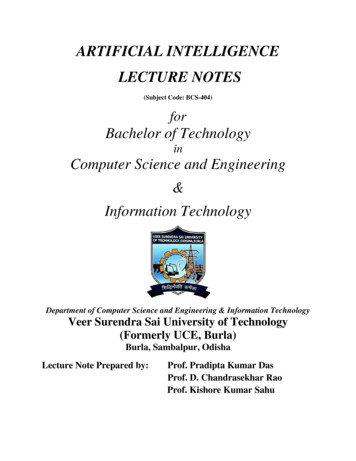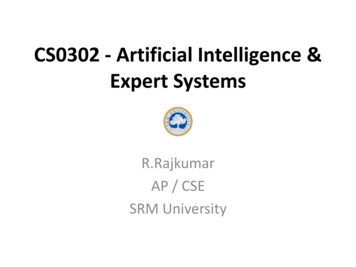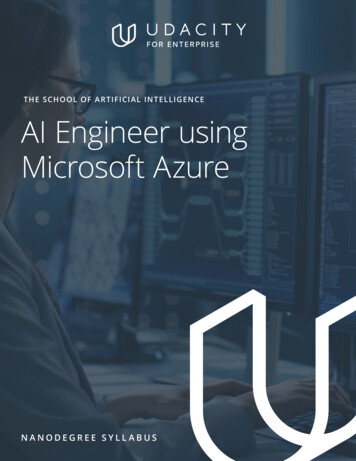
Transcription
T HE S CHOOL OF A R T IFICI A L IN T ELLIGENCEAI Engineer usingMicrosoft AzureNANODEGREE SYLLABUS
OverviewI N CO L L A B O R AT I O N W I T HThe AI Engineer using Microsoft Azure Nanodegreeprogram will equip students with the skills requiredto become an Azure AI engineer or an AI engineerwith expertise in Azure AI and machine learningservices. This program will teach students how toimplement machine learning models, design andbuild an end-to-end AI solution with Azure CognitiveServices, and how to deploy, monitor, and managecontinuous improvement of an Azure AI solution.Students seeking certification who successfullycomplete this program are ideal candidates forMicrosoft certification A1-102.Educational ObjectivesBy the end of this program a student will be able to: Design and build an end-to-end AI solution withAzure Cognitive Services/Azure Cognitive APIs. Design a security strategy that aligns withorganizational policies and complianceframeworks. Deploy, monitor, and manage continuousimprovement of an Azure AI solutionProgram InformationTIME3 monthsStudy 5-10 hours/weekLEVELAdvancedSOFTWARE/HARDWARE AND VERSION REQUIREMENTSAzure Portal (Browser based)VS CodeMicrosoft Bot Framework EmulatorNode.js V16Python 3.6 and aboveVarious Azure cognitive Services SDK (Python)PREREQUISITESPython programming skills: Understand the basics of object-orientedprogramming. Read basic Python syntax, including using whitespace in Python. Distinguish between object types like integers andstrings in scripts. Use Python to build basic algorithms for simpleprograms and scripts that automate common tasks(i.e. renaming files). Write and run basic programming scripts in aterminal that includes function definitionsand loops.Other required skills: Demonstrate knowledge of Microsoft Azure and theability to navigate the Azure portal. Familiarity with a variety of Azure data sources suchas Azure Data Lake and Azure SQL. Demonstrate knowledge of JSON and RESTprogramming semantics and the ability to use APIsin application development.LEARN MORE ABOUT THIS NANODEGREEContact us at enterpriseNDs@udacity.com.*The length of this program is an estimation of total hoursthe average student may take to complete all requiredcoursework, including lecture and project time. If youspend about 5-10 hours per week working through theprogram, you should finish within the time provided.Actual hours may vary.2AI ENGINEER USING MICROSOF T A ZURE
Our classroom experienceREAL-WORLD PROJECTSLearners build new skills through industry-relevantprojects and receive personalized feedback from ournetwork of 900 project reviewers. Our simple userinterface makes it easy to submit projects as often asneeded and receive unlimited feedback.KNOWLEDGEAnswers to most questions can be found withKnowledge, our proprietary wiki. Learners can searchquestions asked by others and discover in real-timehow to solve challenges.WORKSPACESLearners can check the output and quality of theircode by testing it on interactive workspaces that areintegrated into the classroom.QUIZZESUnderstanding concepts learned during lessons ismade simple with auto-graded quizzes. Learners caneasily go back and brush up on concepts at anytimeduring the course.CUSTOM STUDY PLANSCreate a custom study plan to suit your personalneeds and use this plan to keep track of your progresstoward your goal.PROGRESS TRACKERPersonalized milestone reminders help learners stayon track and focused as they work to complete theirNanodegree program.Learn More at WWW.UDACITY.COM/ENTERPRISEAI ENGINEER USING MICROSOF T A ZURE
Learn with the bestAvkash ChauhanValerie ScarlataF O U N D E R A N D P R I N C I PA L AT U N B LO C K E R . A IC U R R I C U LU M M A N A G E R , U DA C I T YAvkash Chauhan has over 20 yearsof software development experienceincluding the last 10 years building AIand ML platforms and solutions forenterprise customers. His previous workexperience includes Microsoft, H2O.ai,Macnica, RoamBee and his own startupsBig Data Perspective and UnBlocker.ai.Valerie is a curriculum manager at Udacitywho has developed and taught a broadrange of computing curriculum for severalcolleges and universities. She was aprofessor and software engineer for over10 years specializing in web, mobile, voiceassistant, and social full-stack applicationdevelopment.Matt SwafferS O LU T I O N S A R C H I T E C TMatt Swaffer is a software and solutionsarchitect focusing on data science andanalytics for Managed Business Solutions.In addition, Matt is an adjunct lecturer,teaching courses in the ComputerInformation Systems department at theUniversity of Northern Colorado where hereceived his PhD in Educational Psychology.4AI ENGINEER USING MICROSOF T A ZURE
Nanodegree Program OverviewCourse 1: Building Computer Vision Solutions with AzureThis course is designed for anyone who would like to use computer vision technology in their applicationto solve a business problem. You will begin by learning what computer vision is and ç through real-lifebusiness use cases. You will then learn to create solutions using different types of vision-based AzureCognitive Services, including Azure Form Recognizer for text extraction, Azure Face and Video Analyzer forfacial detection and recognition, and Azure Computer Vision and Custom Vision for image classification andobject detection. Finally, you will learn and apply the deployment and monitoring tools to ensure that yoursolution is complete and runs smoothly.ProjectAutomated Passenger BoardingKioskIn this project, you will build an automated passenger boarding kiosk. The kiosk will collect passengerand flight information through the passenger’s face image, digital ID, boarding pass, etc. Your objectivewill be to perform various validation processes and confirm if a given passenger can board the plane ornot. You will use various Azure Cognitive Services and supporting services for this project, including AzureComputer Vision, Face, Form Recognizer, Video Analyzer, Azure Blob storage. The run-time environmentwill be Python while you interact with these Azure services.5AI ENGINEER USING MICROSOF T A ZURE
Nanodegree Program OverviewLESSON TITLELEARNING OUTCOMES Identify business and technical considerations for creating computervision applicationsDESIGNCOMPUTER VISIONAPPLICATIONS Identify data considerations and sources for Azure computer visionsolutions Identify various Azure computer vision services for a given businessscenario Identify various programming models to use with Azure CognitiveServices Apply the prebuilt layout recognizer and create a custom layoutEXTRACTING TEXTFROM DIGITALCONTENTrecognizer model to extract the layout of a digital document Apply the prebuilt Azure Form Recognizer service to read the textfrom images and documents Create a custom form recognizer model to collect text data from adigital documentFACIAL DETECTIONAND RECOGNITIONIMAGECLASSIFICATION Understand the terms involved in face detection and recognitionIdentify face(s) in an image or a collection of imagesCreate a custom face recognition model to identify a person’s faceProcess faces in a video using Azure Video Analyzer service Apply image classification and object detection concepts Learn binary and multi-class classification and multi-label imageclassification Create a custom image classification model to classify your ownimagesOBJECT DETECTION &SPATIAL ANALYSIS Learn object detection concepts Create a custom object detection model to identify a specific object Understand the basics of spatial analysisLearn More at WWW.UDACITY.COM/ENTERPRISEAI ENGINEER USING MICROSOF T A ZURE
Nanodegree Program OverviewLESSON TITLELEARNING OUTCOMES Understand and apply computer vision solution deployment,SOLUTIONSDEPLOYMENT &MONITORINGaccessibility, and security Understand and apply application monitoring with extended loggingand enhanced diagnostics Export and delete data and models with cost managementLearn More at WWW.UDACITY.COM/ENTERPRISEAI ENGINEER USING MICROSOF T A ZURE
Nanodegree Program OverviewCOURSE 2: Building NLP and Conversational AISolutions with AzureIn this course you’ll learn how to build conversational AI and NLP solutions on Azure. You’ll begin byexploring use cases for NLP and conversational AI, including chatbots and assistant solutions. Then you’llcreate solution diagrams, model dialogs, and learn about responsible AI principles and practice creatingrequirements for conversational applications. You’ll create and configure bot applications on the Azureplatform using the Microsoft Bot Framework and integrate Azure QnA Knowledge Bases and LUIS Models.In the last part of the course you’ll implement Azure Text and Speech Cognitive Services in applications.ProjectDental Office Virtual AssistantStudents will create a customer support chatbot for a dentist website. They will create a bot on the Azureplatform and a Node.js bot application, create, train, and publish a LUIS Model and QnA Knowledge Base.The bot will use the Azure QnA Knowledge Base and LUIS to answer patient questions and help themschedule appointments. They will deploy the bot application and resources to Azure and implement theassistant on a website.8AI ENGINEER USING MICROSOF T A ZURE
Nanodegree Program OverviewLESSON TITLEDESIGNINGNLP ANDCONVERSATIONALAI SOLUTIONSLEARNING OUTCOMES Create requirements for NLP and conversational AI solutionsincluding creating user stories and dialog modeling Create architecture diagrams based on the components of AzureNLP and Cognitive services Implement responsible AI use of Azure Text Analytics, QnA Maker,and Speech Services Create and configure Bot resources for chatbot and assistantapplications on Azure Create Node.js Bot applications using the Microsoft Bot FrameworkBUILDING BOTSWITH THE BOTFRAMEWORKSDK and templates Identify the components of a Bot Framework application includingcontext, dialog, and adapters Test Microsoft Bot Framework applications using the Bot FrameworkEmulator Configure and deploy bot applications on Azure using Githubcontinuous integration and deployment Use Azure Language Understanding Service (LUIS) to identify intentsand entities in the context of conversational AI solutions Define and train language understanding models with Azure LUISNLP COGNITIVESERVICESservice Use Azure QnA to identify intent in the context of conversational AIsolutions Create QnA Knowledge Bases Implement Language Understanding Services (LUIS) and QnAKnowledge Bases in conversational AI applications Identify and extract entities and key phrases from text using Azuretext analyticsTEXT ANALYTICSAND SPEECHSERVICES Extract phrases and run sentiments analysis on text using Azure textanalytics Speech enable a Bot application with Azure Cognitive SpeechServices and Bot ChannelsLearn More at WWW.UDACITY.COM/ENTERPRISEAI ENGINEER USING MICROSOF T A ZURE
Nanodegree Program OverviewCOURSE 3: Building Knowledge Mining SolutionsWith Azure Cognitive SearchThis course addresses the skills necessary to design and implement an Azure Cognitive Search solution forknowledge mining. In this course, you will learn how to add data sources to Azure Cognitive Search, enrichthe data with AI, properly index the enriched data, and expose the index to client applications for searchscenarios. You will begin by learning how to design an Azure Cognitive Search solution and finish thecourse by building out an AI-enriched data mining application from end to end.ProjectBuild an AI Enriched CorporateTraining CatalogStudents will create a knowledge-mining solution to help employees gain insights into training materialsmade available by their company. They will combine 4 datasets: a set of Udacity courses, a set of MicrosoftLearn courses, a generated set of corporate training, and a set of open-source papers. Students will enrichthese data using built-in skills such as OCR, key phrase extraction, and custom entity recognition, as wellas a custom skill. Students will connect a user-facing search interface to this solution and demonstratevarious query capabilities of the solution.10AI ENGINEER USING MICROSOF T A ZURE
Nanodegree Program OverviewLESSON TITLELEARNING OUTCOMESDESIGNING ANDAZURE COGNITIVESEARCH SOLUTION Create a list of requirements that match various business needs Create a high-level architecture diagram based on the availablecomponents of Azure Cognitive Search Import data from different types of sources using the Azure Portalwizard Implement enrichments such as document cracking and text analysisduring data importIMPORTING DATAINTO AZURECOGNITIVE SEARCH Configure and customize indices to utilize different features of AzureCognitive Search Create and schedule an indexer to populate indexes Create different types of search queries using correct syntax such asbasic, semantic, and fuzzy searching Create properly formed search queries to utilize the range offunctionality available in Azure Cognitive Search such as ordering,filtering, and facetingENRICHING DATA INAZURE COGNITIVESEARCHCONSUMING AZURECOGNITIVE SEARCHIN AN EXTERNALAPPLICATION Fully configure built-in Azure Cognitive Search skills includingupdating the skillset definition, the indexes, and the indexer Fully configure custom Azure Cognitive Search skills includingupdating the skillset definition, the indexes, and the indexer Configure a stand-alone search application to securely connect toAzure Cognitive Search utilizing the search query endpoints Monitor and report on usage metrics such as storage used, numberLearn More at WWW.UDACITY.COM/ENTERPRISEof indices, indexers, and data sources, as well as monitoring metricssuch as search latency and queries per secondAI ENGINEER USING MICROSOF T A ZURE
Our Nanodegree Programs Include:12Pre-AssessmentsDashboard & Progress ReportsOur in-depth workforce assessmentsidentify your team’s current level ofknowledge in key areas. Results are used togenerate custom learning paths designedto equip your workforce with the mostapplicable skill sets.Our interactive dashboard (enterprisemanagement console) allows administratorsto manage employee onboarding, trackcourse progress, perform bulk enrollmentsand more.Industry Validation & ReviewsReal World Hands-on ProjectsLearners’ progress and subject knowledgeis tested and validated by industry expertsand leaders from our advisory board. Thesein-depth reviews ensure your teams haveachieved competency.Through a series of rigorous, real-worldprojects, your employees learn andapply new techniques, analyze results,and produce actionable insights. Projectportfolios demonstrate learners’ growingproficiency and subject mastery.AI ENGINEER USING MICROSOF T A ZURE
Our Review ProcessReal-life Reviewers for Real-life ProjectsReal-world projects are at the core of our Nanodegree programsbecause hands-on learning is the best way to master a new skill.Receiving relevant feedback from an industry expert is a critical partof that learning process, and infinitely more useful than that frompeers or automated grading systems. Udacity has a network of over900 experienced project reviewers who provide personalized andtimely feedback to help all learners succeed.VaibhavUDACITY LEARNER“I never felt overwhelmed while pursuing theNanodegree program due to the valuable supportof the reviewers, and now I am more confident inconverting my ideas to reality.”now atAll Learners Benefit From:Line-by-line feedbackfor coding projectsCODING VISIONS INFOTECHIndustry tips andbest practicesUnlimited submissionsand feedback loopsAdvice on additionalresources to research Go through the lessons and work on the projects that followHow it Works Get help from your technical mentor, if neededReal-world projects areintegrated within theclassroom experience,making for a seamlessreview process flow. Submit your project work Receive personalized feedback from the reviewer If the submission is not satisfactory, resubmit your project Continue submitting and receiving feedback from the revieweruntil you successfully complete your projectAbout our Project ReviewersOur expert project reviewers are evaluated against the highest standards and graded based on learners’ progress.Here’s how they measure up to ensure your success.900 1.8M34.85/5Expert ProjectReviewersProjects ReviewedHours AverageTurnaroundAverage ReviewerRatingYou can resubmit yourproject on the sameday for additionalfeedback.Our learners love thequality of the feedbackthey receive from ourexperienced reviewers.Are hand-pickedto provide detailedfeedback on yourproject submissions.13Our reviewers haveextensive experiencein guiding learnersthrough their courseprojects.AI ENGINEER USING MICROSOF T A ZURE
Udacity 20212440 W El Camino Real, #101Mountain View, CA 94040, USA - HQFor more information visit: www.udacity.com/enterpriseUdacity Enterprise Syllabus AI Engineer using Microsoft Azure Nov-2021
4 AI ENGINEER USING MICROSOFT AZURE. Valerie Scarlata. CURRICULUM MANAGER, UDACITY. Valerie is a curriculum manager at Udacity . who has developed and taught a broad . range of computing curriculum for several . colleges and universities. She was a professor and software engineer for over 10 years specializing in web, mobile, voice


